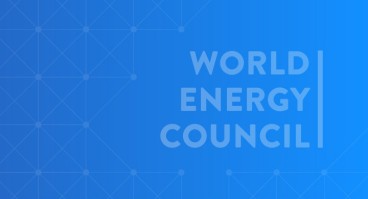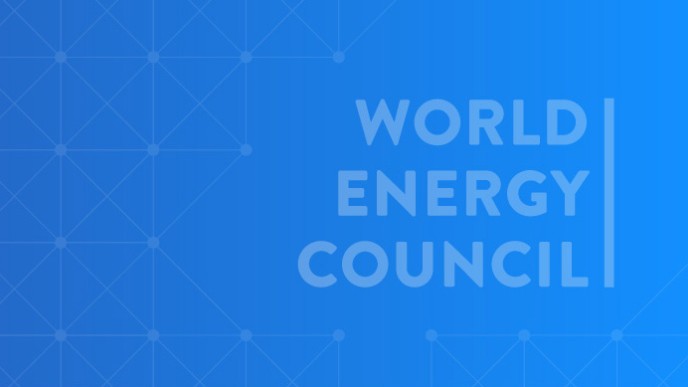Africa Network
The Africa regional network currently spans from Algeria, Tunisia and Egypt in the North to Namibia and Kingdom of Eswatini in the South, including many Central African countries. While the continent is endowed with untapped human capital and significant conventional and renewable energy resources, an estimated 600 million people still lack access to electricity.
National Member Committees are interested in engaging in activities and events that provide opportunity to collaborate cross-border to establish dialogue, foster an exchange of impartial views and best practice, and identify common areas of research and action on issues such as energy access and affordability, energy efficiency, regional integration and interconnectivity, cross-border and trans-continental power transmission network, and tapping the entrepreneurial potential of grassroots innovation.
To facilitate these activities, the African regional network is developing working level relationships with African Union Commission (AUC), COMESA, ECOWAS, African Energy Commission (AFREC), and Association of Power Utilities of Africa (APUA).
Regional action priorities that support the Council’s mission and humanising energy vision are agreed on an annual basis by national Member Committees in the framework of a Regional Action Plan.
Each month, the African regional network meets to discuss matters of mutual interest, drive collective activities, and keep each other updated on relevant developments and events. In addition, throughout the year regionally targeted workshops are being organised to advance discussions in the context of our global insights and innovation tools.
As part of World Energy Week LIVE 2021, a conversation focusing on Capacity building for a net-zero Africa was convened. While many African countries who signed the Paris Agreement have set out on an ambitious plan to reduce their carbon emissions to zero by 2050, many pledges and efforts by governments to tackle the causes of global warming, GHG emissions are still growing drastically. Participants explored what African countries can do to accelerate the implementation of those ambitious target and how they can prepare their populations and workforces to face some of the unavoidable changes and empower them to be enablers of a successful transition.
Furthermore, countries like Kenya and Nigeria are working to launch their own World Energy Academies aimed at advancing in capacity building and energy literacy in the region.
Some countries in the region have developed national Future Energy Leaders Programmes. These work closely with national Member Committees and support activities at the national and regional level
Energy in Africa
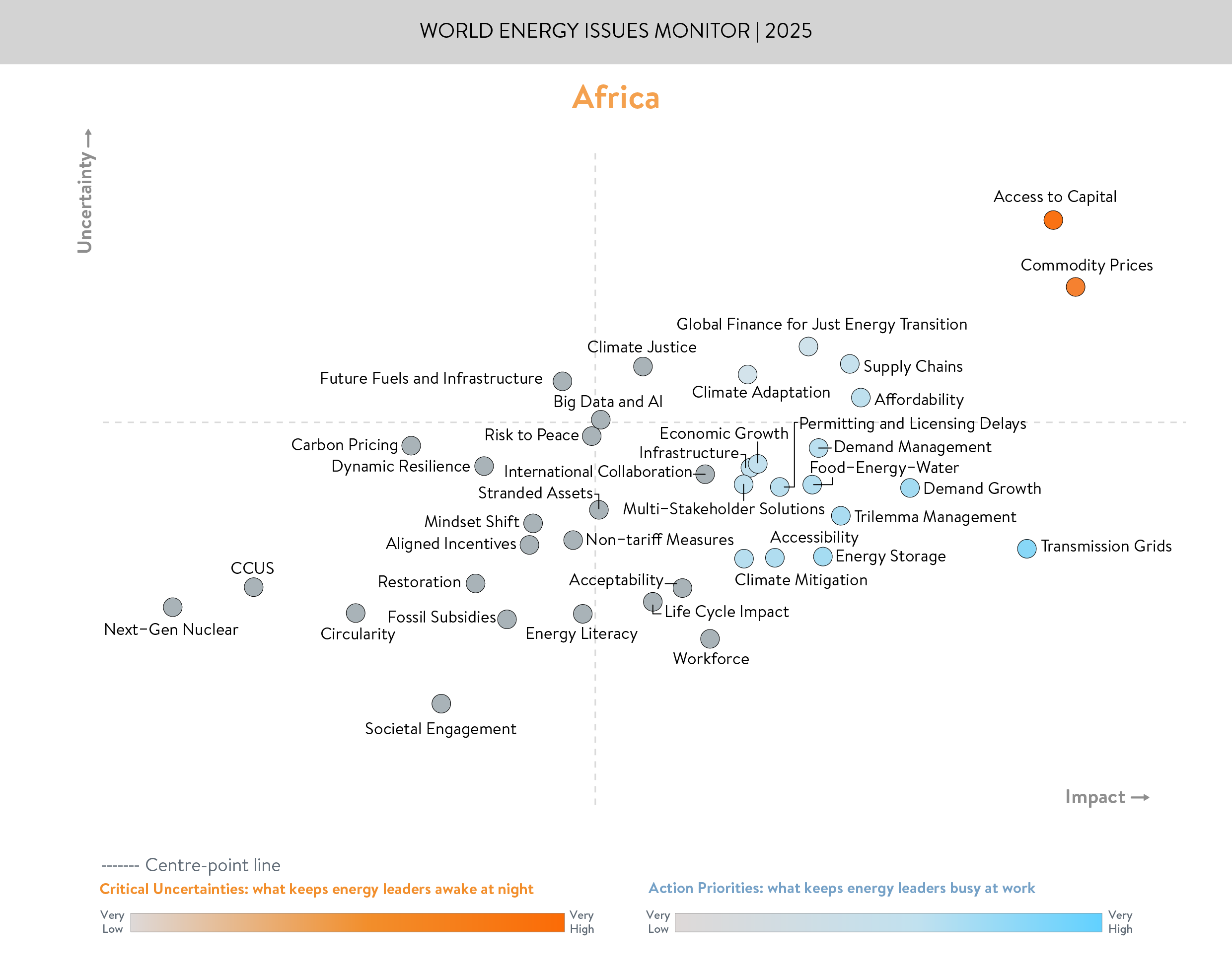
INTRODUCTION
Africa’s energy transitions are defined by two urgent challenges: expanding access to reliable, affordable energy while building climate resilience in the face of challenging environmental and economic risks. With over 600 million people still lacking access to electricity, the continent is navigating a complex task shaped by diverse local contexts, rapid population growth, and uneven infrastructure development.
Amid significant investment gaps and rising climate vulnerabilities, the region is also home to bold innovations and progress is emerging in many areas. Morocco has achieved near-universal electrification through large-scale solar investments like the Noor Solar Complex, while South Africa and Kenya are piloting domestic renewable manufacturing and community-based grid initiatives. Nigeria’s smart grid reforms are improving reliability in urban centres, and cross-border trading through SAPP and WAPP is strengthening regional integration.
The 2025 World Energy Issues Monitor highlights the critical role of infrastructure development, transmission grid expansion, and demand growth in shaping Africa’s energy future. Efforts like the African Continental Power System Master Plan (CMP), led by the African Union Development Agency (AUDA-NEPAD), reflect growing momentum for coordinated regional solutions. As the continent confronts growing demand, social equity, and climate volatility, success will hinge on robust regional collaboration, creative financing solutions, a concerted effort to build local capacity and expertise, and inclusive community participation to ensure transitions are resilient, equitable, and locally led.
|
About the World Energy Issues Monitor Energy transitions are complex, evolving, and deeply interconnected, shaped by shifting priorities, emerging uncertainties, and regional realities. Since 2009, the World Energy Issues Monitor has offered a unique lens into the dynamic forces driving energy transitions worldwide. This year’s survey spans 39 core transition issues across six categories – spotlighting blind spots, new signals, and shifting leadership priorities. Amid growing uncertainty, leaders across the World Energy Council community are asking sharper questions: What’s working? What can be adapted across regions? And where are the real opportunities to turn blind spots into bright spots? |
CRITICAL UNCERTAINTIES AND ACTION PRIORITIES
Top Critical Uncertainty: Access to Capital
Despite abundant solar, wind, and hydropower potential, many large-scale energy projects remain stalled due to a lack of affordable, long-term financing. High interest rates, concerns over political risks, and currency volatility push up borrowing costs, leaving major developments on hold.
- Difficult Investment Landscape: Africa’s energy investment landscape faces significant hurdles, with high investor risk premiums limiting access to affordable financing. Domestic lending remains constrained, while international banks often impose elevated rates, pushing developers toward smaller, incremental projects instead of large-scale, cross-border expansions that could reduce costs. Africa accounts for only 7% of global Public-Private-Partnership (PPP) investment, with activity concentrated in a few countries—Egypt, Morocco, Nigeria, South Africa, Kenya, and Uganda. Many projects struggle to scale or sustain impact, reflecting persistent financing and governance barriers.
- Gender Gap in Access to Finance: Only 1% of venture capital funding in Africa goes to women-led startups. This limits women’s ability to participate in and lead energy projects, despite their critical role in managing household energy needs. Addressing this gap requires innovative financing mechanisms, such as gender-responsive credit guarantee schemes and blended finance models, must become central pillars of inclusive transition strategies.
- Africa Energy Bank Launch: Slated to begin operations in early 2025, this much-anticipated institution will pool capital to fund transformative energy initiatives, such as region-spanning transmission lines and larger-scale solar farms. Its success may reduce the perceived risks that have long kept interest rates high.
Top Action Priority: Transmission Grids
Modernising and expanding Africa’s transmission networks is essential—not only for electrification and industrial growth, but also for stabilising supply amid increasingly frequent climate shocks. Many parts of Africa are interconnected, but this needs to be strengthened and expanded to increase energy security and facilitate renewable energy generation.
- Regional Interconnectors via SAPP and WAPP: Through the Southern African Power Pool (SAPP) and West African Power Pool (WAPP), cross-border lines move surplus renewable power to high-demand zones. Some countries benefit from remote hydro or solar sites now feeding distant industrial centres, enhancing cost efficiency. The African Union Development Agency (AUDA-NEPAD) is working with the five African Regional Power Pools to align planning and investment toward a future single electricity market. Its flagship initiative—the Continental Power System Master Plan—sets out a coordinated vision for electricity generation and transmission, requiring over $1 trillion to implement. Several key milestones have already been reached, though regulatory complexity and financing barriers remain.
- Overcoming Investment Barriers in Grid Modernisation: Securing long-term capital for grid modernisation remains a critical challenge across Africa. Expanding transmission corridors often involves navigating multiple regulatory bodies and complex approval processes, which delay project implementation. Many countries in the region rely heavily on government funding, as high perceived risks and limited financial frameworks deter private and external investors. This capital gap not only hinders necessary grid upgrades to integrate renewable energy but also compromises the development of a resilient and interconnected energy system.
|
Box 1: Energy-Cyber Nexus – AI and Grid Resilience in Africa
|
BLIND SPOTS AND BRIGHT SPOTS
Energy transitions are helping African industries and communities thrive by capitalising on abundant renewable resources, yet the decarbonisation of the broader system is still in its infancy. Progress tends to be uneven and frequently delayed by financial uncertainties, limited local engagement, and weak infrastructure. The 2025 data reveals:
Blind Spots
- Societal Engagement & Gender Inclusivity
Women are frequently underrepresented in energy planning and decision-making, despite being primary energy users—especially in rural areas where they often spend significant time collecting firewood and managing household energy needs. Enhancing the involvement of women through community-driven approaches and gender-sensitive policies can lead to more inclusive and successful energy projects. Kenya’s Lake Turkana Wind Power Project succeeded in part due to early, inclusive stakeholder engagement. In contrast, limited consultation has delayed large-scale projects like the Grand Inga hydropower initiative in the Democratic Republic of Congo (DRC).
- Climate Adaptation & Justice
Droughts, floods, and rising temperatures increase vulnerability, yet adaptation planning across the energy sector remains limited. Rural communities reliant on agriculture face high risks, especially where resilience planning lags behind energy access goals.
- Workforce & Skills Development
African energy leaders rank workforce concerns low in impact, but new technologies (utility-scale solar, energy storage) depend on qualified local talent. Women remain underrepresented, limiting inclusive workforce capacity.
Bright Spots
- Localised Renewable Manufacturing
Localised renewable manufacturing can help mitigate commodity price fluctuations by developing domestic supply chains for critical minerals like lithium and cobalt. Although Africa holds over 70% of the world's cobalt reserves, most of its processing occurs off-continent. By building local value chains, nations can stabilize prices while generating employment and economic opportunities, especially for women and youth. For instance, Morocco and South Africa are advancing domestic production of solar and wind technology components to drive economic growth and enhance social upliftment.
- Morocco’s Renewable Access & Grid Expansion
Achieved near-universal electrification within about 15 years, underpinned by major wind and solar investments (Noor Solar Complex). Grid enhancements provided a blueprint for scaling low-carbon power and improving living conditions in off-grid regions.
- Kenya’s Lake Turkana Wind Power
Africa’s largest wind farm (310 MW) overcame early local concerns via transparent benefit-sharing. This project demonstrates that engaging communities directly can jumpstart renewables at scale.
- Nigeria’s Smart Grid Initiatives
Distribution utilities, regulated by the Nigerian Electricity Regulatory Commission (NERC), introduced digital tools to minimise outages. These small but focused reforms have helped ensure more stable supply in targeted areas, helping to stabilise supply and rebuild public confidence.
|
Box 2: Key Implications for Humanising Energy – Africa
|
CONCLUSION
Much like observing a flock of birds in flight—each individual movement contributing to a larger, dynamic pattern—Africa’s energy transition reveals a complex interplay of challenges and opportunities. The data confirms that:
- Access to Capital remains the region’s top critical uncertainty. Investor risk, regulatory fragmentation, and high borrowing costs continue to delay large-scale clean energy development. The African Energy Bank, set to launch in 2025, offers a new vehicle to de-risk projects and pool capital at scale.
- Transmission Grids are the most urgent action priority. Regional platforms such as SAPP and WAPP show early success in linking surplus renewable generation with demand centres. Expanded, modernised grids are essential to energy security and economic growth.
- Blind Spots include limited societal engagement, gaps in climate adaptation, and workforce development challenges. Without stronger community involvement and gender inclusivity, inclusive progress will remain uneven.
- Bright Spots are emerging. Morocco’s accelerated renewable deployment and grid expansion, Kenya’s successful stakeholder engagement in the Lake Turkana Wind Power Project, and Nigeria’s innovative smart grid reforms, are leading examples of African leadership driving meaningful change.
Africa’s path forward depends on deepening local innovation and fostering local manufacturing, scaling community-driven solutions engagement, and unlocking the full potential of regional cooperation to deliver an inclusive, just, and resilient energy future.
KEY CONTRIBUTORS
In addition to thanking experts from across our community for their contributions, we would like to make special mention of Victor Sibiya, Senior Manager of the Energy Council of South Africa; Eng. Yvonne Shumba; Noureddine Hamri, Founder of Turn Up the Light, Morocco, and Future Energy Leader at the World Energy Council.
Downloads
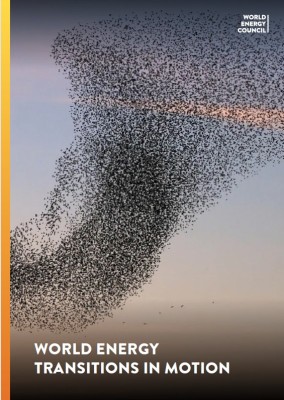
World Energy Issues Monitor 2025
Download PDF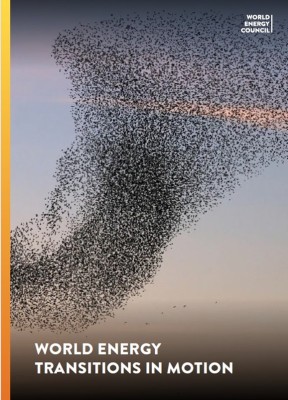
World Energy Issues Monitor 2025 - Africa Regional Commentary
Download PDF



